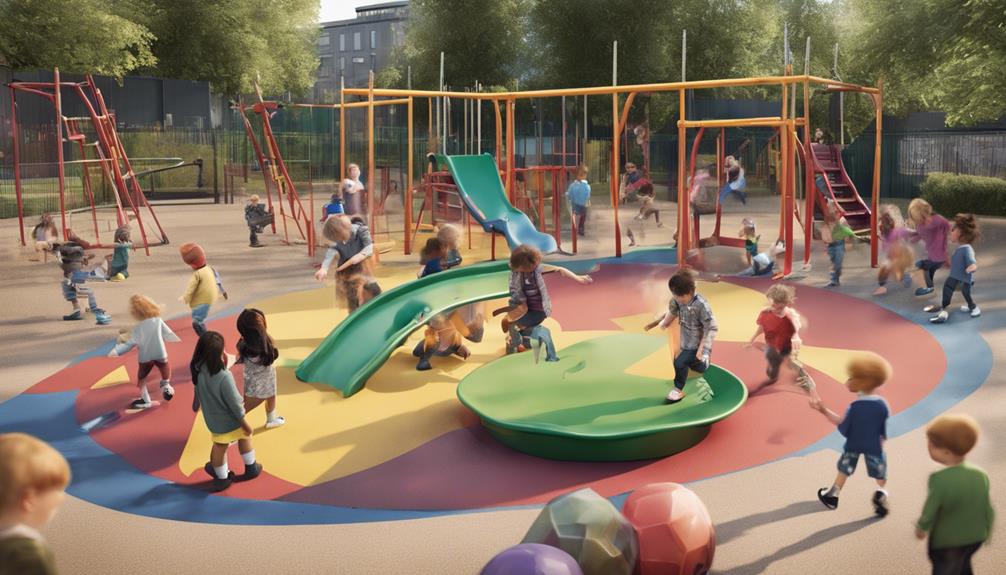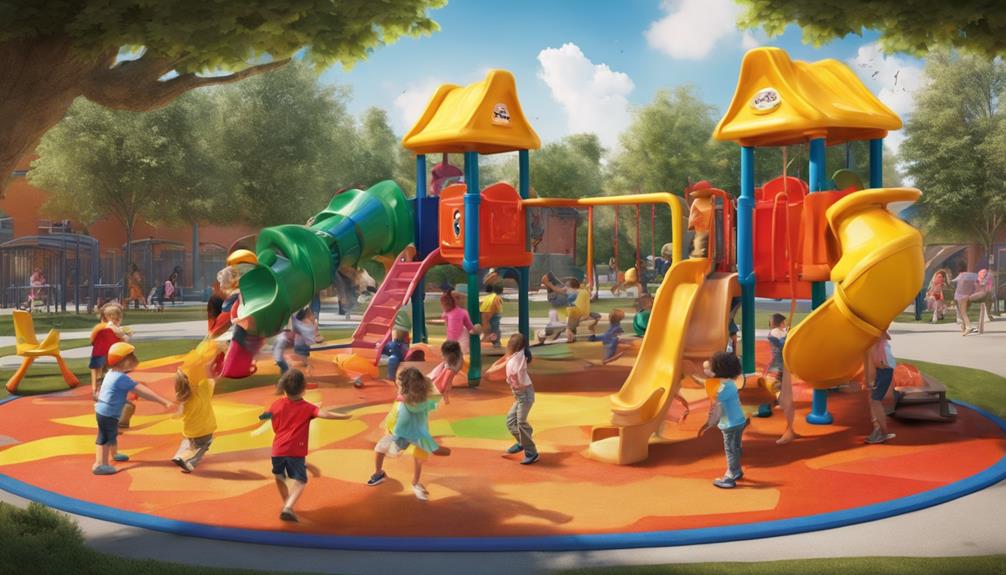As we begin on the journey of understanding the 5 Developmental Domains, it's like revealing a complex tapestry where each thread intricately weaves into the next, forming a complete picture of a child's growth.
Exploring how physical, cognitive, language, social-emotional, and adaptive skills interconnect can shed light on the multifaceted nature of child development.
Revealing the significance of these domains not only broadens our perspectives but also equips us with invaluable tools to navigate the intricate path of supporting children's holistic development.
Key Takeaways
- Physical development supports interaction with the environment and overall health.
- Language development is essential for effective communication and expression.
- Emotional well-being benefits from understanding emotions and building healthy relationships.
- Social interactions shape relationships, social skills, and promote teamwork and collaboration.
Overview of Developmental Domains
In exploring the developmental domains, we find that they encompass vital aspects of a child's growth and well-being. Each domain – physical, cognitive, language, social-emotional, and adaptive development – contributes uniquely to a child's holistic development. Physical development involves the mastery of motor skills, such as crawling, walking, and running, along with sensory development that helps children understand the world through touch, taste, smell, sight, and sound.
Cognitive development, on the other hand, focuses on mental processes like problem-solving, memory, and language acquisition. It's through cognitive development that children learn to think, reason, and understand the world around them. Language development enables children to communicate effectively, express their thoughts and feelings, and engage with others in meaningful ways.
Social-emotional development is integral for emotional regulation, acquiring social interaction skills, and building empathy. These skills are essential for forming relationships, navigating social situations, and understanding others' emotions. By honing their social-emotional skills, children learn to regulate their emotions, interact positively with peers, and develop empathy towards others, fostering healthy relationships and emotional well-being.
Importance of Physical Development

Evidencing the critical role of physical development, children's growth in motor skills, sensory capabilities, and overall physical well-being forms a cornerstone of their holistic development.
- Motor Skills: From the foundational gross motor skills involved in walking and running to the intricate fine motor skills essential for tasks like grasping objects and writing, physical development plays an essential role in a child's ability to interact with their environment effectively.
- Nutrition and Physical Activity: Proper nutrition, engaging in physical activities, and creating environments that support movement are significant aspects of fostering ideal physical development in children. These factors not only contribute to physical well-being but also aid in the development of motor skills.
- Monitoring and Milestones: Recognizing and celebrating milestones in physical development, such as crawling, walking, and the ability to grasp objects, are important markers of a child's progress. Regular monitoring and support in physical development can enhance overall health and promote proficiency in motor skills, ensuring a strong foundation for future growth.
Language Development Essentials

Understanding the foundational elements of language development is essential for fostering effective communication skills in children. Language development encompasses phonology, which involves the sounds used in language, syntax, the rules governing sentence structure, semantics, the meaning of words and sentences, and pragmatics, the social use of language.
By the age of 2, toddlers typically begin using telegraphic speech, combining words to convey simple messages. Verbal communication skills progress at different rates for each individual, highlighting the importance of tailored support. Strong language development is critical for successful communication, as it serves as a powerful tool for expressing thoughts, emotions, and needs.
Nurturing these skills early on can enhance a child's ability to interact with others effectively. By recognizing the significance of language development in shaping communication skills, we can better support children in expressing themselves and connecting with those around them.
Nurturing Emotional Well-being

As we explore the developmental domains, nurturing emotional well-being becomes central to promoting resilience and positive mental health.
- Understanding Emotions: Encouraging children to understand and manage their emotions effectively is pivotal for building emotional intelligence and promoting resilience. By teaching them to identify and express their feelings, we help them develop a strong foundation for positive mental health.
- Building Healthy Relationships: Supporting emotional well-being involves fostering healthy relationships and positive social interactions. Children who feel validated and understood in their emotions are more likely to form secure attachments and navigate social situations with confidence.
- Teaching Coping Strategies: Equipping children with coping strategies and problem-solving skills is essential for enhancing their emotional well-being. By providing them with tools to manage stress, overcome challenges, and regulate their emotions, we empower them to navigate life's ups and downs with resilience and adaptability.
Social Interactions and Growth

Social interactions are essential for a child's growth and development, shaping their ability to form relationships and navigate social situations. Positive social interactions play a crucial role in helping children build empathy, communication skills, and conflict resolution abilities, ultimately fostering emotional intelligence. Engaging in group activities and cooperative play enhances social skills, teamwork, and collaboration among children. The table below highlights the key benefits of social interactions in child development:
| Benefits of Social Interactions | |
|---|---|
| Development of empathy | Improved communication skills |
| Enhanced conflict resolution abilities | Fostering emotional intelligence |
| Strengthening social skills | Teamwork and collaboration in group activities |
| Learning social norms and sharing | Development of friendships and turn-taking practice |
Through frequent social interactions, children not only boost their self-esteem but also experience improved social adjustment and overall well-being. Encouraging children to engage in social activities from a young age can have a significant impact on their social development and future relationships.
Frequently Asked Questions
What Are the 5 Developmental Domains?
We recognize the 5 developmental domains important for child growth: physical, cognitive, language, social-emotional, and adaptive development. Each area plays an essential role in shaping a child's abilities and interactions with the world.
What Are the 5 Major Domains in Which Development Is Assessed?
We assess development in physical, cognitive, language, social-emotional, and adaptive domains. From motor skills to social interactions, tracking these areas helps understand a child's growth. It's essential for overall well-being and guides interventions for support.
What Are the Five Domains of Learning Outlined in These Guidelines?
We explore physical, cognitive, language, social-emotional, and adaptive domains in child development. Each domain contributes uniquely to a child's growth and abilities. Understanding these areas allows us to support holistic development in children effectively.
What Are the 5 Domains of the Whole Child?
We see the child as a garden flourishing with physical, cognitive, language, social-emotional, and adaptive blooms. Each petal, unique yet interconnected, shapes their growth. These domains intertwine, nurturing the whole child towards a vibrant future.
Conclusion
In exploring the 5 developmental domains, we've unearthed the intricate tapestry of a child's growth. Just as a flower needs sunlight, water, and care to bloom, children require support in physical, cognitive, language, social-emotional, and adaptive areas to thrive.
By understanding and nurturing these areas in harmony, we can sculpt resilient, well-rounded individuals who can navigate life's challenges with grace and confidence.
Let's be the gardeners of their potential, cultivating a brighter tomorrow.










